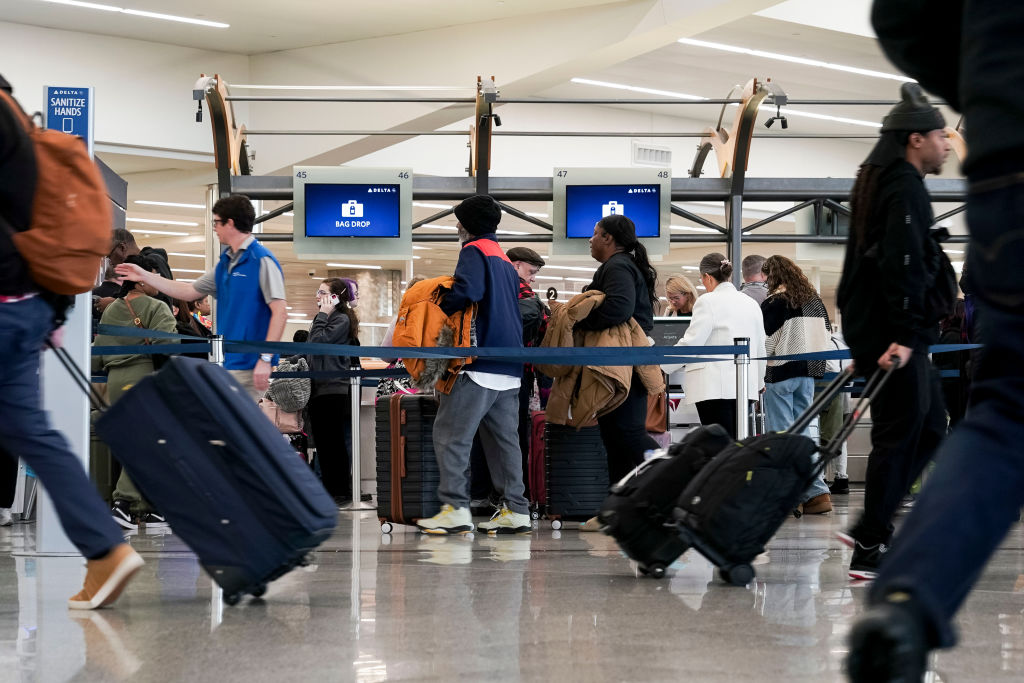How the Government Shutdown Could Disrupt Your Travel Plans
Airports remain open for now, but a prolonged shutdown could bring longer lines, slower processing and closures at parks and museums.


The U.S. government officially shut down on October 1, after Congress failed to reach a budget deal. For travelers, that doesn’t mean flights grind to a halt right away — but the longer the shutdown drags on, the greater the chance of delays and headaches.
Airport security screeners, air traffic controllers and customs officers are considered essential, so they’ll keep working through the shutdown. The catch is that they won’t be paid until it ends, and in past shutdowns, that’s led to staffing shortages as frustration builds.
If this shutdown stretches on, travelers could start to see longer lines, slower processing and other ripple effects across the system. Here’s what to expect if your plans overlap with a prolonged government shutdown.
From just $107.88 $24.99 for Kiplinger Personal Finance
Become a smarter, better informed investor. Subscribe from just $107.88 $24.99, plus get up to 4 Special Issues

Sign up for Kiplinger’s Free Newsletters
Profit and prosper with the best of expert advice on investing, taxes, retirement, personal finance and more - straight to your e-mail.
Profit and prosper with the best of expert advice - straight to your e-mail.
What happens to travel in a long government shutdown
The U.S. travel economy now risks losing $1 billion per week due to disruptions in air and rail travel and the shutdown of national parks and cultural institutions, according to Tourism Economics.
A shutdown halts appropriations to such agencies as the Federal Aviation Administration (FAA), Transportation Security Administration (TSA) and Customs and Border Protection. While essential services continue, hiring, training and other critical support functions stall, creating ripple effects that worsen the longer funding is frozen.
For now, essential workers (e.g. screeners, air traffic controllers, customs officers) remain on duty — but without pay until the funding is restored.
The real pressure point for air travelers during a government shutdown occurs when frustrated federal employees tire of not receiving a paycheck and start calling out sick in large numbers, as they did during the 35-day government shutdown in late 2018 and early 2019.
When TSA agents and air traffic controllers are stretched thin, airport lines grow longer, wait times extend into hours, and travelers begin to feel the brunt of the shutdown.
How the government shutdown could affect your upcoming trip

If you’re hitting the road or catching a flight in the coming days, the shutdown shouldn’t immediately derail your plans. Airport security, customs and air traffic control are still operating, though the employees working those jobs aren’t being paid. For now, that means most trips will move ahead as scheduled.
The real concern comes if the shutdown stretches on. As workers miss paychecks, staffing levels can thin, leading to longer lines and slower processing at TSA checkpoints — even for travelers using Clear, TSA PreCheck or Global Entry.
To stay ahead, lean on holiday travel best practices: Allow extra time; bring TSA-approved snacks; and brace for delays. With record numbers of passengers expected this season, patience will be essential if the shutdown continues.
Other ways a government shutdown impacts travel plans
Even if you're not traveling by air, your travel and holiday plans could still be disrupted by a government shutdown, because it could also result in the closing of national parks, federally owned museums, monuments and attractions.
Many people who work in those places aren't deemed essential. In 2018-2019, many of these federal tourist attractions furloughed workers and were either closed or operated with skeleton staffs that resulted in subpar conditions, such as overflowing toilets and garbage cans.
If you were planning to drive to a nearby park or attraction, double-check that it's open before you go.
Takeaways of a government shutdown's impact on travel
Travelers wondering how their trips might be impacted if the government shuts down should look at what happened during the longest-ever government shutdown in 2018 and 2019 as a roadmap.
Here are some takeaways:
Duration of the shutdown matters. In the last shutdown, news reports of hour-plus-long lines at airports, flight delays, and the closing of some terminals at major airports such as Miami International Airport didn’t occur until mid-January 2019, or roughly three weeks into the shutdown.
The staff shortages at airports caused by government workers calling out sick tended to pick up when these federal employees missed their first or second paycheck and started to feel the financial squeeze.
Check your documents. Getting a passport might also take longer due to staffing shortages. It’s possible that passport offices located inside federal buildings could close, too.
Do your homework. Most experts say a government shutdown isn’t a reason for travelers to cancel their trips, unless a national park you planned to visit is closed. What travel experts do recommend is doing your homework before you head to the airport, hop on a train or jump in the car to set off on a trip.
“Call ahead, do your research and see what’s open and what’s not,” said Sarah Kopit, editor-in-chief at Skift. “Make sure you can get to where you’re going. And then make an informed decision as to whether it’s worth it (to go).”
If you do decide to travel during a government shutdown, leave extra time in the event there are delays at the airport.
Related Content
Profit and prosper with the best of Kiplinger's advice on investing, taxes, retirement, personal finance and much more. Delivered daily. Enter your email in the box and click Sign Me Up.

Adam Shell is a veteran financial journalist who covers retirement, personal finance, financial markets, and Wall Street. He has written for USA Today, Investor's Business Daily and other publications.
-
 'Humbug!' Say Consumers, Despite Hot GDP: Stock Market Today
'Humbug!' Say Consumers, Despite Hot GDP: Stock Market Today"The stock market is not the economy," they say, but both things are up. Yet one survey says people are still feeling down in the middle of this complex season.
-
 The SEC Is Concerned for Older Investors and Retirement Savers. Here's What You Should Know
The SEC Is Concerned for Older Investors and Retirement Savers. Here's What You Should KnowThe SEC focusing on older investors, retirement and college savers, and private securities. Here's how those changes impact you.
-
 Vesting, Catch-Ups and Roths: The 401(k) Knowledge Quiz
Vesting, Catch-Ups and Roths: The 401(k) Knowledge QuizQuiz Test your understanding of key 401(k) concepts with our quick quiz.
-
 How to Protect Yourself and Others From a Troubled Adult Child: A Lesson from Real Life
How to Protect Yourself and Others From a Troubled Adult Child: A Lesson from Real LifeThis case of a violent adult son whose parents are in denial is an example of the extreme risks some parents face if they neglect essential safety precautions.
-
 Here's How Much You Can Earn with a $100,000 Jumbo CD
Here's How Much You Can Earn with a $100,000 Jumbo CDYou might be surprised at how fast a jumbo CD helps you reach your goals.
-
 A Financial Planner Takes a Deep Dive Into How Charitable Trusts Benefit You and Your Favorite Charities
A Financial Planner Takes a Deep Dive Into How Charitable Trusts Benefit You and Your Favorite CharitiesThese dual-purpose tools let affluent families combine philanthropic goals with advanced tax planning to generate income, reduce estate taxes and preserve wealth.
-
 How Financial Advisers Can Best Help Widowed and Divorced Women
How Financial Advisers Can Best Help Widowed and Divorced WomenApproaching conversations with empathy and compassion is key to helping them find clarity and confidence and take control of their financial futures.
-
 Your Guide to Buying Art Online
Your Guide to Buying Art OnlineFrom virtual galleries to social media platforms, the internet offers plenty of places to shop for paintings, sculptures and other artwork without breaking the bank.
-
 I'm 59 With $1.7 Million Saved and Just Lost My Job. Should I Retire at 59½, or Find New Work?
I'm 59 With $1.7 Million Saved and Just Lost My Job. Should I Retire at 59½, or Find New Work?We asked professional wealth planners for advice.
-
 Metro by T-Mobile Is Giving Away This Samsung Galaxy A16: Which Plans Are Eligible?
Metro by T-Mobile Is Giving Away This Samsung Galaxy A16: Which Plans Are Eligible?Metro by T-Mobile is offering free Samsung Galaxy A16 phones on eligible plans right now. Here’s how the deal works.
-
 I Drive and Collect Classic Cars: Here’s How I Got in the Game Without Spending a Fortune
I Drive and Collect Classic Cars: Here’s How I Got in the Game Without Spending a FortuneAre classic cars a hobby or an investment strategy — or both? Either way, the vintage car scene is much cooler and more affordable than you think.